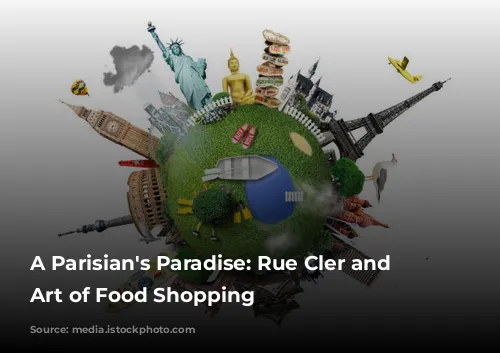Imagine a charming street nestled in the shadow of the Eiffel Tower, a haven of delicious delights and local charm. This is Rue Cler, my favorite Parisian street, and it’s a world away from the bustling city that surrounds it. With shops overflowing onto the cobblestones, it feels like stepping into a village, a vibrant slice of life in the heart of Paris. And for me, there’s no greater pleasure than strolling down Rue Cler, gathering ingredients for a picnic under the Parisian sun.

A Gourmet’s Journey
My Parisian adventures have transformed my palate, opening my eyes (and taste buds) to the world of French cuisine. Gone are the days of thinking cheese was just orange and bread was only for sandwiches. Now, I appreciate the artistry of food and the French dedication to good living. This newfound appreciation has led me to explore the nuances of French food shopping, an experience that’s far from just grabbing groceries.

The Social Dance of Food Shopping
In Paris, shopping for food is more than a chore; it’s a daily ritual, a social dance woven into the fabric of Parisian life. With tiny kitchens and a preference for the freshest ingredients, Parisians visit their local shops almost daily. It’s a chance to catch up with the butcher, admire the florist’s latest grandchild, share a coffee with friends, and indulge in the quintessential French greeting of cheek kisses (two for acquaintances, three for those you haven’t seen in a while).

Freshness Above All
From vibrant produce stalls to bustling fishmongers, Rue Cler is a symphony of aromas and flavors. Every morning, trucks arrive laden with fresh produce, transported from farmers’ markets with the speed and precision of FedEx. Parisians, ever-conscious of sustainability, favor reusable trolley carts over plastic bags. They reject pre-packaged produce, opting instead for the bounty of the season, savoring the taste of fresh, local ingredients.

The Art of Smell and Selection
The air on Rue Cler is a fragrant invitation to indulge your senses. Parisians, with their discerning palates, approach the produce with an almost ritualistic touch, sniffing the cheap foreign strawberries and then inhaling the rich perfume of the local gariguettes. Their eyes scan the shelves, checking the origins of every melon, a detail mandated by law. Out of season, these sweet fruits arrive from the French Caribbean, while most Parisians turn their noses at imported produce, favoring the unique flavors of their own region.

A World of Cheese
The fromagerie (cheese shop) is the olfactory heart of Rue Cler, a pungent paradise for cheese lovers. Wedges, cylinders, balls, and miniature hockey pucks, all dusted with white, grey, and burnt marshmallow, form a mesmerizing landscape of cheese. A simple “Ooh la la” expresses admiration, while “Ooh la la la la!” indicates a truly impressive cheese. My friend Marie, a Parisian true to her roots, once held a particularly pungent cheese to her nose, took a deep, almost orgasmic breath, and declared, “Yes, this smells like zee feet of angels.”
This small shop boasts over 400 varieties of French cheese, a testament to the country’s cheesemaking heritage. In the back room, you’ll find les meules – massive, 170-pound wheels of cheese, each made from 250 gallons of milk. These giants are the source of the hard cheeses, their thick rinds meant for rolling, not eating. However, the rinds of smaller cheeses like brie and camembert are integral to the taste, as Marie would say, “It completes the package.”

A Culinary Symphony
Rue Cler is a treasure trove of gourmet delights, with each shop offering a unique taste of Parisian life. The charcuterie (or traiteur), a Parisian staple, offers mouthwatering prepared foods, perfect for busy dinner party hosts. These delis allow for the tiny Parisian kitchens to focus on the main course while outsourcing beautifully prepared side dishes, creating a symphony of flavors.
At the boucherie, the air is alive with the aromas of fresh meat. Parisians browse not just beef, pork, and chicken, but also a plethora of other meats, including rabbit (lapin), quail (caille), lamb (agneau), and duck (canard). You’ll also find more adventurous options, like kidneys (rognons), liver (foie), and even heart of beef (coeur de boeuf). Though horse meat has fallen out of favor, the head of a calf remains a local delicacy, prized for its many flavorful parts. To ensure the highest quality, Parisians check the duck’s feet, which should be rough and calloused, a sign that the bird has enjoyed a life outdoors. The selection at the boucherie varies with the season, with game meats hanging from the ceiling in winter.

Bread and Pastry: A Delicate Balance
The debate over the supremacy of bread versus pastry rages on in Parisian cooking schools. Bakers-to-be choose to specialize in either bread or pastries, as the prevailing wisdom holds that excellence in one category comes at the expense of the other. But on Rue Cler, the baker defies this notion. The baguettes are perfect for sandwiches, while the pastries are a delightful picnic treat, offering the best of both worlds.

The Final Touch: Wine
No Parisian shopping trip is complete without a visit to the local wine shop. Parisians often save this stop for last, selecting a wine that perfectly complements the meal they’ve assembled. If you’re not as familiar with the nuances of wine as the average Parisian, don’t hesitate to engage the knowledgeable staff, who are adept at pairing wines with your tastes, menu, and budget. Don’t let the low prices fool you; France is renowned for its high-quality “wines of the month,” often available for under $10. Even without a sale, you can find excellent wines for $10–15.

A Sensory Journey Awaits
On your next visit to Paris, take some time to explore the charming streets and vibrant food shops. Let your senses guide you through a sensory adventure that will leave you with memories to cherish. And remember, a simple “Bonjour, Madame,” “Merci,” and “Au revoir” will go a long way in making a good impression. Bon appétit!




